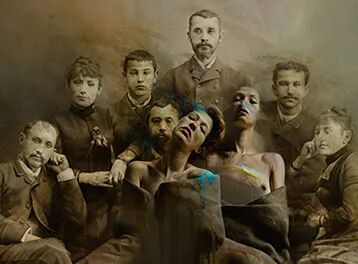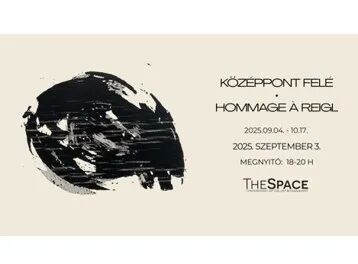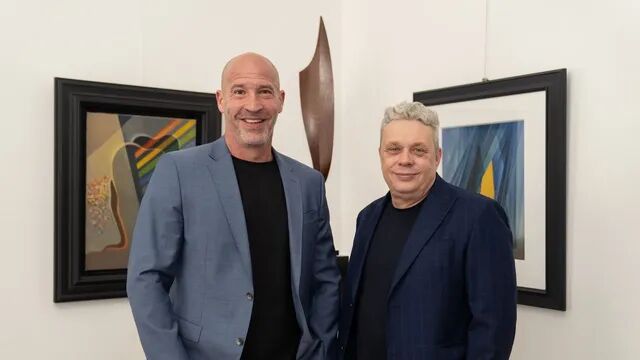A new selection from Péter Horn’s collection will be on display in the non-profit section of the Budapest Contemporary Fair in September. The cornerstone is Dezső Váli for the fourth time already, but this time in dialogue with young artists. Several works by Váli are included in the collection, of which three exhibitions have already been set up in the past two years. In 2022, a selection covering all periods of his life’s work was on display in Kálmán Makláry's gallery, followed by versions of the same at the Liszt Institute in Stuttgart in 2023 and still on show at the Vastuskós House in Győr until the end of December 2024.
The current fourth exhibition shows that the collection opened up to young artists. Works by György Király, Róbert Lak and Botond Kuti were recently acquired by Péter Horn. The stylistic affinity between the paintings of Váli and Király is particularly close, with silence being their common denominator. How is it possible to evoke not only the silence of the physical environment, but also a mystical, inner silence, with just a few objects - studio props or tableware?
Lak and Kuti's paintings also draw from dynamics. The amorphous, organic blobs of colour carry a fresh turmoil and tension alongside the timelessness of ancient forms. Their inspirational experience is not even identifiable as an object, but rather as a vision, a cascade of clashing forces, a waterfall of colours spilling over into each other. It is a world beyond the real, surreal.
For the two young artists, this is also a link to Váli, especially to his early, surrealist-inspired period, as well as to the early work of other artists in the collection. The legacy of surrealism was crucial for Judit Reigl, who moved on from it to free gesture-based image creation. Reigl also has a large number of paintings in Peter Horn's collection. Alongside the private collection of the foundation that manages the artist's legacy and Kálmán Makláry, this material is among the largest collection in the world.
Like Reigl, Ferenc Fiedler became a sovereign artist in Paris after the Second World War. The brushwork in his paintings is dominamilleniumted by currents and swirls, and this stir provides the link to the directions mentioned so far. It is no coincidence that Peter Horn acquired a large number of works by him from the middle of the second millennium, making him one of the owners of one of the most significant Fiedler collections, alongside the FondationMaeght collection. Reigl and Fiedler's works were added to the collection in such high numbers at a time when they were little known, at least in Hungary, and they represented the joy and excitement of rediscovering a forgotten treasure.
In addition to the two French-Hungarian artists, other figures who immigrated to Paris, such as Zsigmond Kolozsváry and Antal Bíró, are also represented in the collection, which is thus deemed as one of the main reclaimers of Hungarian art in France. All the more so because István Sándorfi's work is also one of the cornerstones of Péter Horn's collection. While his Parisian career makes him akin to these artists, his virtuoso figurativeness also sets him apart from them. In his early period, this technical proficiency served as a means of generating the tension hidden in his works, while in his later canvases with more subtle themes, the superiority of his craftsmanship and the consciously made 'mistakes' and sketches contrast each other.
István Nyári, who is also represented in the collection with several works, offers a parallel to Sándorfi, since his meticulously painted pictures also draw the viewer in through their apparent lifelikeness and raw expressiveness, through the visual representation of repressed violence.
The review so far has highlighted three main focuses of the collection. Dezső Váli and the metaphysical silence, contemplative engagement, the economy of a few recurring visual motifs condensed into small images, and the power of self-discipline form one of the blocks. Reigl, Fiedler and other Hungarians from Paris make up the other group, which is partly organised around the story of finding a new homeland abroad and then, after the turn of the millennium, symbolic returnin total to their homeland to Hungary. While Váli is marked by an ascetic, repetitive life and visual world, by loyalty to a few chosen values and the depth of their exploration, Reigl and his peers' trajectory and visual medium is one of an explosive search for freedom, of rebellion against the Hungarian limitations left behind. The third cornerstone is the Sándorfi-Nyári duo, whose brilliant figurativeness and portrayal of the tensions of the human soul provide an independent focus.
It is already clear that Péter Horn is a collector who does not base his collection on an art history arc or a theoretical concept, but chooses according to his own taste. A businessman who manages a large company responsibly and with precision, he frees himself from his suit in the art market and gives free rein to his personality. However, the structured manager is also present. Whichever artist Horn chooses, he collects their work extensively. It is understandable that, with such a large financial investment, he wants to make rational, mutually reinforcing decisions that exploit a particular direction; he also keeps himself informed of the international art market, for example by following the website artfacts.net. And just as important is the motivation behind the carefully considered choice of an artist to be systematically included in the collection, the intention that this collection should be able to present the artists in question in a comprehensive and internationally relevant way, and thus shape the artistic canon.
Two other blocks are evidence of this approach. János Balázs and other Roma artists, such as Tamás Péli, are represented in the collection by as many important works as the professional artists mentioned above. This is a forward-looking gesture towards Roma artists, as it suggests to the public that it is not origin or artistic education that is decisive, but the authenticity of the visual world. And why shouldn't Balázs's soaring imagination be as much a depository of surrealism's dreams and desires as the works of the great masters? Why shouldn't Balázs be as much a great figure in the search for human and artistic freedom as Reigl? Both of them, all of them, were refugees from the Hungarian reality, from its captivity, rebelling against prejudices based on the colour of their skin or even their gender identity.
The 83 János Balázs paintings in the collection were shown in a solo exhibition at the Kunsthalle in 2019, followed by a different selection three years later at the Hungarian Cultural Institute in Brussels and in 2023 at the Szentandrássy Gallery in Budapest, which specialises in Roma art. In this way, a private collector is taking on a public, artistic-social mission - along with the intellectual and material valorisation of the works he owns.
The collection also seeks to present the art of László Drégely with the intention of positioning and revaluation. Péter Horn focuses on the works of the 1960s from the lifework of several thousands of pieces of art, where the visionary world is not far from surrealism. Drégely, who worked as a set designer for theatre and film and for Hungarian Television, was diagnosed with a serious illness at a young age, and creating works of art held the promise of eternity for him. Supporting Drégely shows that Peter Horn is a manager-collector who not only seeks ready-made, secure values, but also experiences collecting as a self-fulfilment, where he can take the positions he has discovered and considered undervalued to a higher level of acceptance.
In total, the collection systematically collects eighteen major artists, along with other, no less prestigious artists - for example, works from the early period of Sándor Molnár are among the collection's highlights. In addition to the in-depth collection, the two series of exhibitions of paintings by Dezső Váli and János Balázs are also a testimony to the intention to present them to the public and to make them known to a wider audience. No less impressive is the Horn Collection's presence on social media: since 2022, the collector has been posting a work a week on Instagram, and has been using conscious online marketing to reach international audiences. The tens of thousands of followers is an impressive achievement in a global comparison of art platforms. At the very least, the collector is no longer just a buyer, but a curator through weekly selections and a communicator and art mediator through well thought-out online distribution. Together, the series of exhibitions and the post-series make the collector almost an institution.
All in all, over the last twenty to twenty-five years, Péter Horn has become one of the leading figures in the Hungarian scene of collectors. He has had a strong presence in the post-WWII and contemporary art market from the outset, and in the third edition of the Edge Communications series of booklets on contemporary private collectors issued in 2009 he was already displayed with the major emphases that still define his collection recent.
The recent past has brought two new turns. With a large number of works of outstanding quality already in his possession from the artists who are the focus of the collection, Peter Horn has decided to open up the possibilities - for example, new genres beyond painting, international positions besides the Hungarian material, female artists besides the predominantly male ones – and all this is put in focus the first time by the current exhibition. Among the possible directions, an opening towards young people has started and is being presented. The other shift is active arts management on three fronts: through exhibition series, online communication and corporate patronage ranging from national professional journals to support for art fairs.
This evolutionary story is also a good example of how the creative art collector is not only present in the art world with his money, but also with his actions.




